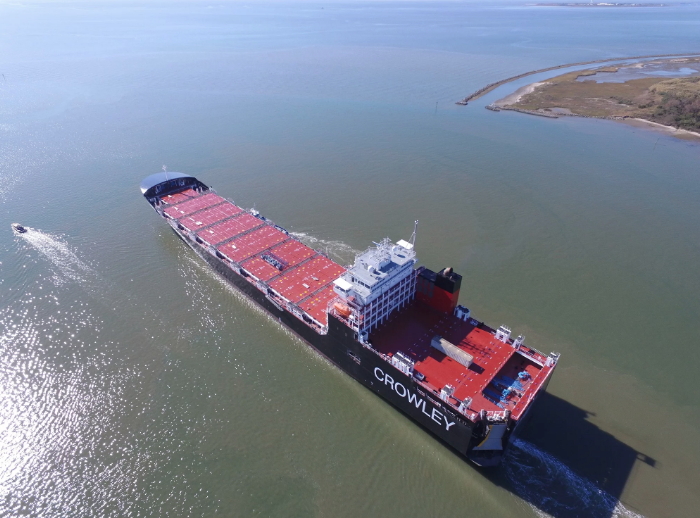Crowley Maritime Corp. announced Thursday that it has taken delivery of the Taíno, second in a pair of the world’s first combination container roll-on/roll-off (ConRo) ships powered by liquefied natural gas (LNG).
VT Halter Marine Inc., Pascagoula, Miss., delivered the Taíno recently and sistership El Coquí, which was delivered in July. Crowley says the two 720', 26,500-dwt Commitment-class vessels will be “providing fast, reliable and environmentally friendly shipping and logistics services between Jacksonville, Fla., and San Juan, Puerto Rico,” a route the company has served since 1954.
Crowley invested $550 million in the ships and associated port upgrades. Taíno is scheduled to make her maiden voyage to San Juan on Jan. 8 from Crowley’s dedicated U.S. mainland port at the Jacksonville Port Authority (JAXPORT), Jacksonville, Fla.
Designed specifically for the Puerto Rico trade, the ships carry up to 2,400 20' equivalent container units (TEUs) at a cruising speed of 22 knots. A range of other container sizes and types can be accommodated, including 53’x8.5’ boxes and up to 300 refrigerated containers. Enclosed and ventilated roll-on/roll-off decks accommodate around 400 cars and larger vehicles.
“This type of shipboard garage is offered exclusively by Crowley in the trade,” according to a company statement.
“I want to congratulate and thank all the men and women at Crowley and VT Halter Marine who helped to bring these marvelous new ships to life,” said Tom Crowley, company chairman and CEO. “They are shining examples of maritime innovation and craftsmanship available right here in the United States thanks to the Jones Act.”
“From a business standpoint, Taíno and El Coquí are key components of our integrated logistics offerings that are bringing speed to market and creating a competitive advantage for our customers in Puerto Rico and the Caribbean,” Crowley said. “With our own vessels and proprietary transportation and distribution network, we’re reducing friction and complexity while increasing the velocity of customers’ goods moving to market and reducing their landed costs.”
“VT Halter Marine is proud to be part of the Crowley Commitment-class project,” said VT Halter Marine President and Chief Executive Officer Ron Baczkowski. “We applaud Crowley Maritime’s vision, leadership, and commitment to provide technologically advanced and environmentally friendly ships to support its Puerto Rico trade.”
Construction was managed in the shipyard by Crowley Solutions. This team included naval architects and engineers from company subsidiary Jensen Maritime, Seattle.
"The men and women of American Maritime Officers stand with Crowley in celebrating the Taíno's commencement of service in the Jones Act Puerto Rico trade," said Paul Doell, national president of AMO, the union that represents the licensed officers aboard the Commitment Class ships. "We're proud to be part of Crowley's expanding cargo service between the mainland and Puerto Rico and the ongoing innovation under the U.S. flag as America's next-generation fleet of LNG-powered vessels continues to grow."
“Taíno is named for the original native Puerto Ricans who lived off the land with great appreciation and respect for their environment, and El Coquí is named for the popular indigenous frog on the island,” according to the company.
Fueling the ships with LNG reduces emissions significantly, including a 100% reduction in sulphur oxide (SOx) and particulate matter (PM); a 92% reduction in nitrogen oxide (NOx); and a reduction of carbon dioxide (CO2) of more than 35% per container, compared with current fossil fuels. Working with Eagle LNG Partners, the ships are bunkered from a shoreside fuel depot at the JAXPORT facilities in Jacksonville.
At San Juan, the company’s Isla Grande terminal upgrades included a new 900’x114’ concrete pier and associated dredging needed to accommodate the two new ships; three new ship-to-shore gantry cranes; expanding terminal capacity for handling refrigerated containers; paving 15 acres to accommodate container stacking; adding containers and associated handling equipment to its fleet; installing a new electrical substation to provide power for the new gantry cranes; constructing a new seven-lane exit gate for increased efficiency; and installing hardware required for a new, state-of-the-art terminal operating software system.




